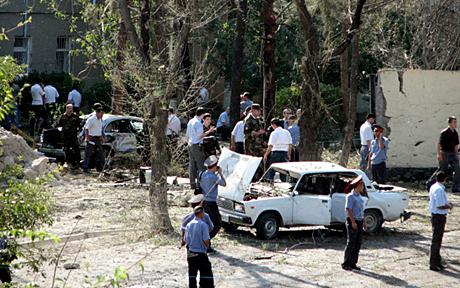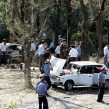
Islamic Extremist Group Jamaat Ansarullah Overcomes Tajikistan’s Inter-Tribal Conflicts
Publication: Eurasia Daily Monitor Volume: 9 Issue: 174
By:

On September 11, Tajikistan’s Supreme Court reached a final verdict in a case against 15 alleged members of the banned Islamic militant group, Jamaat Ansarullah. In the closed trial hearing, 12 of the defendants were sentenced to prison terms between five and 24 years. According to the court ruling, the condemned persons were involved in the following events: fighting in the Karategin Valley in 2010–2011; a terrorist attack in September 2010 in the city of Khujand in northern Tajikistan; and an attempt to commit a series of terrorist attacks in Dushanbe. Most of the defendants were arrested during the operation against field commander Abdullo Rahimov—a.k.a. Mullo Abdulo, who was killed on April 15, 2011—in Tajikistan’s eastern Karategin Valley in April 2011 (see EDM, September 13). According to Dushanbe, Jamaat Ansarullah is the Tajikistani branch of the Islamic Movement of Uzbekistan (IMU) and is sponsored by al-Qaeda (Ferghananews.com, September 11).
Jamaat Ansarullah, also known as the Society of Allah’s Soldiers, first came to light in September 2010 when the heretofore unknown organization claimed responsibility for a suicide attack on September 3 in the city of Khujand in Tajikistan’s northern province of Sughd. An explosives-packed car rammed into the building of the organized crime department of the regional police, killing two officers and two civilians and wounding 28 people. The suicide bomber was local resident Akmal Karimov, trained in al-Qaeda camps in Afghanistan and Pakistan (Reuters, December 26, 2011).
The activity of Jamaat Ansarullah has direct links with events in the volatile Karategin Valley in 2010 in central western Tajikistan. On August 24, 2010, more than two dozen prisoners escaped from a detention center in the capital of Tajikistan after a bloody shootout. All were originally arrested during fighting in the Karategin Valley in July 2009. These escaped prisoners returned to the Karategin, sparking new military operations in the region by the government. On September 3, the above-mentioned suicide attack occurred in Khujand. Then, on September 19, 2010, a defense ministry convoy seeking to apprehend the escaped prisoners came under a grenade attack in the Kamarob Gorge in the Karategin Valley. At least 28 soldiers were killed. The authorities blamed Mullo Abdullo for the ambush, and additional government forces were sent to the area to hunt down the attackers. Analysts argue that the events on August 24, September 3 and September 19 were directly connected. Moreover, according to Dushanbe, Jamaat Ansarullah’s banner was found in the place where Abdullo’s armed group was eventually destroyed by government forces seven months later (see EDM, September 13; Asia Plus, May 3).
In September 2011, Jamaat Ansarullah issued several videos calling on Tajikistan’s citizens to embrace jihad against “infidels” and urging them to take action to support the implementation of Islamic Sharia law. “Those who pray namaz, who follow fasting rules but support democracy are nonbelievers,” a man on the video said. “Allah is killing nonbelievers by our hands and, thus, blesses us.” Some politicians and experts, however, doubt whether these videos can really be traced back to Jamaat Ansarullah. According to one former leader of Tajikistan’s opposition, the famous Tajik spiritual leader Hoji Akbar Turajonzoda, “the videos are a provocation backed by anti-Islamic forces.” Member of Parliament and chief deputy of the Islamic Renaissance Party (IRP—a legal, moderate Islamic party in Tajikistan) Saidumar Hussaini said, “In our country an organization by the name of ‘Jamaat Ansarullah’ does not exist. Even among those groups that have been banned, it does not exist, and I doubt that such an organization exists anywhere in the world” (Centralasiaonline.com, September 29, 2011; see EDM, May 8).
The majority of the Jamaat Ansarullah members sentenced by Tajikistan’s Supreme Court on September 11 are from the Isfara district in Sughd province. Isfara is a very special region in Tajikistan. The population there is more religious than in other areas of the country. Three natives of Isfara fought on the side of the Taliban during Operation Enduring Freedom, and were held at Guantanamo Bay by the United States. Furthermore, the Islamic Renaissance Party is particularly strong in the Isfara region and, in the 2000 parliamentary elections, won the majority vote of this district’s population. Moreover, in Isfara’s main fundamentalist Islamic enclave—the village of Chorku—93 percent of the votes cast were for the IRP. The author, who visited Chorku in 2005 and 2010, witnessed that the village strictly prohibited alcohol consumption and required women to veil themselves while in public (see EDM, January 4, 2005).
The Isfara district of Sughd provice is dangerous also because of its geographic location. Isfara is located in the Ferghana Valley section of Tajikistan, only a few kilometers from Uzbekistan’s and Kyrgyzstan’s parts of this ethnically complex area. Ferghana is widely considered to be one of the most potentially volatile regions in Central Asia (see EDM, September 21).
It bears pointing out that the union between Karategin and Isfara Islamic militants under the banner of Jamaat Ansarullah is an important symbolic event because it reflects a case of militant groups overcoming inter-tribal cleavages in favor of a transcendent ideology. Tribalism is a serious problem for Tajikistan; the political struggle here has been practically indivisible from the inter-regional and inter-ethnic one. Indeed, during Tajikistan’s Civil War (1992–1997), a coalition of Garm (Karategin) and Pamir Tajiks fought against Kuliab and Sughd Tajiks (see EDM, September 13). During the Civil War, Karategin Tajiks used Islamist slogans and their enemy, Sughd Tajiks followed the secular and even communist ideology. Now, it appears that Islamic militants from different regions of the country have overcome these tribal contradictions.




